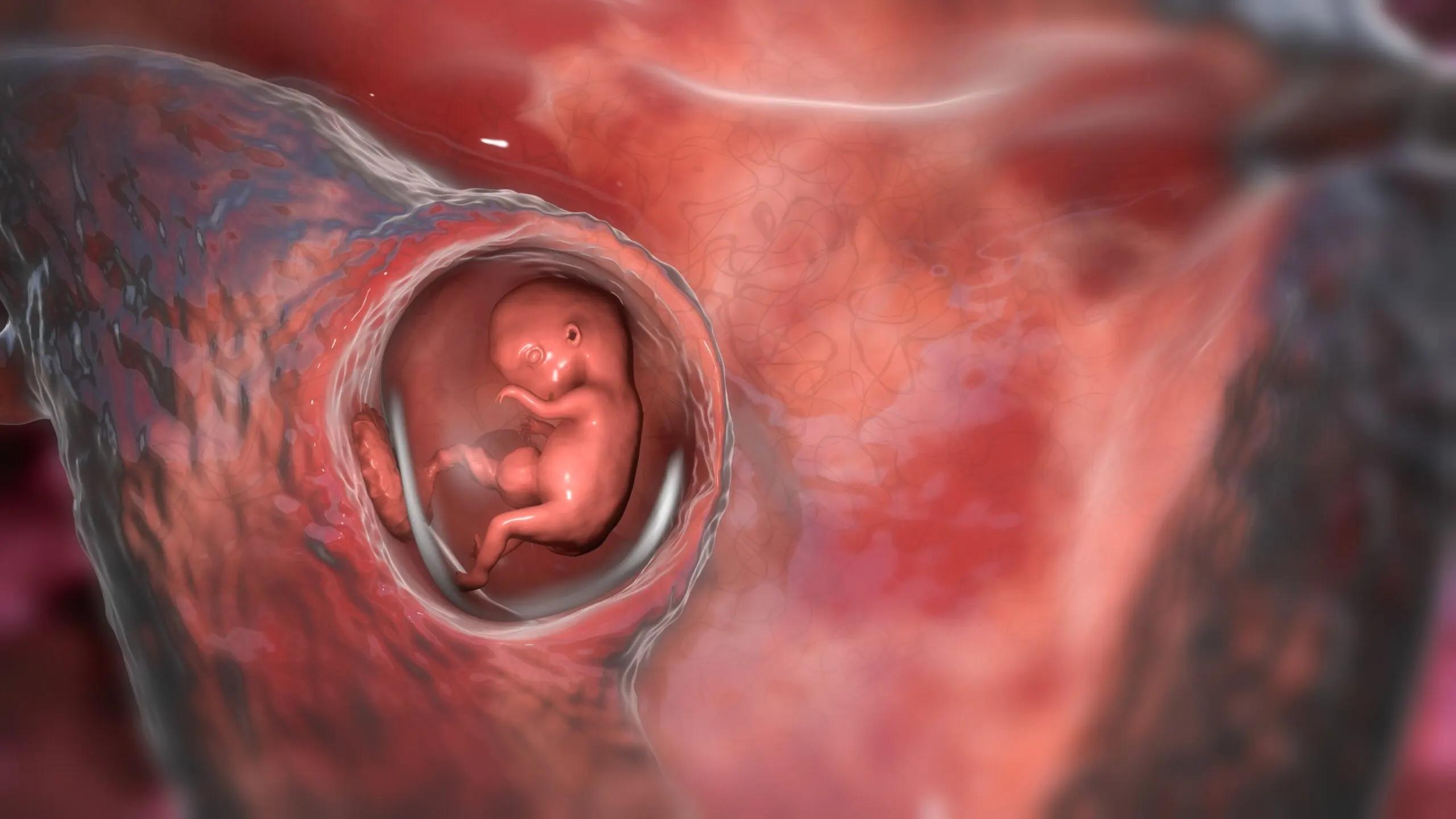The Mucous Plug in Pregnant Women: What Is It and What's Its Function?


Written and verified by the doctor Mariel Mendoza
The mucus plug of the pregnant woman can be observed when the due date approaches as a clear, pink, yellowish, bloody, or reddish-brown mucus discharge. That’s why it’s also called bloody discharge, although it’s not specifically that.
This plug is a product of mucus formation in the cervical canal and functions as a hermetic barrier that prevents microorganisms from entering the uterus.
Although its expulsion does not necessarily indicate the onset of labor, it does indicate that it’s coming soon. Learn what you need to know about it in this article.
What is a mucus plug in pregnant women?
The mucus plug is produced by the accumulation of mucus in the cervix. This secretion is produced by the endocervical mucus glands, which hypertrophy (enlarge) in the first weeks of gestation.
Its composition is varied:
- Water
- Mucus
- Phosphates
- Enzymes
- Proteins
- Electrolytes
- Immunoglobulins
This mucous plug is located just at the top of the vaginal canal. Thus, it closes the cervix, protecting the baby until it is ready to be born.
What is its function?
The primary function of the mucous plug of the pregnant woman is to create a separation barrier between the interior of the uterine cavity and the vaginal canal. It is a physical barrier, preventing both the access of saprophytic fungi and bacteria that inhabit the vagina, as well as other microorganisms.
However, in addition to acting as a physical barrier, the presence of immunoglobulins also contributes to the defense against pathogens. Immunoglobulins repel potentially infectious microorganisms that could reach the uterine cavity.
We think you may also enjoy reading this article: Vagal Response in Pregnancy: What Is It and How to Prevent It?
Is the mucous plug really useful in preventing the ascent of bacteria?
The ascent of bacteria from the urinary tract or the vaginal canal can infect the placenta and amniotic fluid, causing complications during pregnancy. Vornhagen et al. in 2018 published a study of the self-antimicrobial activity of pregnant mucous plug components. They showed that the concentration of antimicrobials was insufficient to kill bacteria, but it does possess sufficient proteins capable of activating leukocytes (white blood cells) and thus the immune system.
On the other hand, Hansen et al. mention that the mucous plug has intense antimicrobial activity against Staphylococcus saprophyticus, Sthapylococcus aureus, Escherichia coli, Pseudomonas aeruginosa, Enterococcus faecium, Streptococcus pyogenes and Streptococcus agalactie. All these microorganisms have been associated with preterm delivery and neonatal complications.
The plug has no activity against Ureaplasma spp. which is the bacterium most commonly found in amniotic fluid in cases of premature rupture of membranes.

When is the mucus plug expelled?
The mucus plug is expelled due to the presence of contractions that cause cervical changes. Therefore, it does not in itself mark the beginning of labor; rather, it’s the beginning of uterine activity.
It’s expelled when the cervix begins to change (to dilate or open). Expulsion may occur weeks or days before the actual onset of labor, or just at the onset of labor.
Expulsion is considered normal between 38 and 42 weeks of gestation. Although its expulsion cannot give a precise indication of when labor will begin, it’s common for uterine contractions to begin immediately afterward.
In case of suspected expulsion of the mucus plug before 37 weeks of gestation, a doctor should be consulted urgently.
What happens if it’s expelled early?
The early expulsion of the mucus plug of the pregnant woman should be evaluated according to the week of gestation. We know that the expulsion is usually caused by dilatation and softening of the cervix. So, this would be a sign that the anatomical area is changing.
When the plug is expelled in the first trimester of pregnancy, it is not necessarily a sign of a problem. There may be more susceptibility to infection, but the uterus will produce a new plug again.
Sometimes it’s expelled after a medical vaginal examination or after penetrative intercourse.
But when the expulsion occurs after the second trimester of pregnancy and before 37 weeks, you should see a doctor urgently. In this scenario, there is a risk of premature delivery.
The doctor will order an ultrasound to measure the length of the cervix. This data reveals whether there is a possible cervical incompetence and, therefore, a threat of preterm labor.
The goal will be to avoid delivery before 37 weeks of gestation. When it’s imminent and the progression of contractions can’t be stopped, the common choice will be to perform pulmonary maturation of the fetus and programming of the baby’s care at preterm birth.
Like this article? You may also like to read: Pregnancy Triggers Brain Changes to Promote Bonding with Children, Studies Show
What is the rupture of membranes and how can you differentiate it from the expulsion of the mucus plug?
Several symptoms are associated with the onset of labor. The expulsion of the mucus plug is only one of them and can occur up to weeks before the baby is born, as we have already mentioned.
In fact, one of the most characteristic symptoms of the onset of labor is the rupture of membranes, also known as “water breaking”. It occurs when the amniotic sac enveloping the baby ruptures.
This releases the clear amniotic fluid, which comes out abruptly. Women often think that they urinated unintentionally. After the rupture of membranes, the onset of contractions is common.
The rupture of membranes should not be confused with the release of the mucus plug. They are different episodes, somewhat related, but not the same.
The mucus plug detaches entirely from the cervix and has the consistency of egg white or gelatinous. Its color is variable: it can be transparent, whitish, yellowish, pinkish (with threads of blood), or reddish brown.
Sometimes it’s also expelled in parts. It may go unnoticed or be barely noticeable when wiped with toilet paper.

What should be done after the expulsion of the mucus plug?
After the expulsion of the mucus plug from the pregnant woman, it’s recommended to be attentive to other signs or prodromes of the onset of labor:
- Increased frequency and intensity of uterine contractions.
- Rupture of the membranes with leakage of amniotic fluid.
Be attentive, because these are signs that your baby is coming soon! On the other hand, if you think you expelled the mucus plug before 37 weeks, you should see your doctor. You should also do so if the mucus plug is abundant and bright red, green, or foul-smelling.
All cited sources were thoroughly reviewed by our team to ensure their quality, reliability, currency, and validity. The bibliography of this article was considered reliable and of academic or scientific accuracy.
- Cavero L. Saldivar D. Obstetricia y medicina Materno-fetal. Ed. Medicapanamericana. 2017
- Cedeño-Marín, C. L., Barzallo-Pazhar, M. R., & Velásquez-Pesántez, J. M. (2023). Incompetencia cervical: presentación de un caso. Revista Metropolitana de Ciencias Aplicadas, 6(1), 134-139. http://remca.umet.edu.ec/index.php/REMCA/article/view/608
- González C, Salas A, Arroyo R. (2010). Cuello uterino en embarazo y parto. Ginecología y Obstetricia de México, 78, 2, 121-127. https://www.medigraphic.com/pdfs/ginobsmex/gom-2010/gom102j.pdf.
- Hansen L, et al. (2014). The cervical mucus plug inhibitis, but does not block, the passage of ascending bacteria from the vagina during pregnancy. Acta obstetricia et Gynecologica Scandinavica, 93, 102-108. https://obgyn.onlinelibrary.wiley.com/doi/epdf/10.1111/aogs.12296.
- Lacroix G, Gouyer V, Gottrand F, Desseyn J. (2020). The Cervicovaginal Mucus Barrier. Int J Mol Sci, 21, 21, 8266. https://www.ncbi.nlm.nih.gov/pmc/articles/PMC7663572/
- Medley, N., Poljak, B., Mammarella, S., & Alfirevic, Z. (2018). Clinical guidelines for prevention and management of preterm birth: a systematic review. BJOG: An International Journal of Obstetrics & Gynaecology, 125(11), 1361-1369. https://obgyn.onlinelibrary.wiley.com/doi/abs/10.1111/1471-0528.15173
- Sociedad Española de Ginecología y Obstetricia. (S.F.) ¿Estoy de parto?. SEGO. https://sego.es/mujeres/Inicio_parto.pdf.
- Vornhagen J, et al. (2018). Human Cervical Mucus Plugs Exhibit Insufficiencies in Antimicrobial Activity Towards Groups B Streptococcus. The Journal of Infectious Diseases, 217, 1626-1636. https://academic.oup.com/jid/article-abstract/217/10/1626/4841651
This text is provided for informational purposes only and does not replace consultation with a professional. If in doubt, consult your specialist.








